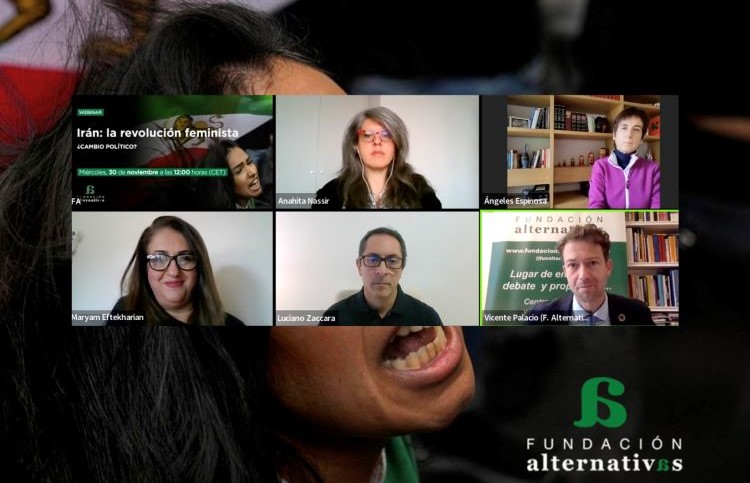The Diplomat
Alternativas Foundation analyzed last Wednesday the massive protests registered in Iran following the murder of young Mahsa Amini by the police, which constitute a “feminist revolution” that aspires to change the regime and which also has “the support of men”.
Last Wednesday, the Alternativas Foundation organized an on-line debate entitled Iran and the feminist revolution, political change?, in which the latest events in the country were analyzed after the murder of Amini on September 19 in Tehran at the hands of the police, which has served as a trigger for “a massive protest by Iranian women throughout the country”.
The debate, moderated by Vicente Palacio, director of Foreign Policy of the Alternativas Foundation, put on the table the keys to what is happening in the regime of the ayatollahs: the causes of the protests and their dimension in society, the current situation of Iranian women, the expectations of political change towards a democratic model, the possible ways of influence from the Iranian diaspora abroad or the scenarios that are opening up both internally and regionally in the Middle East and Persian Gulf.
Ángeles Espinosa, journalist and writer, former correspondent of El País in Tehran, pointed out that Iran has a “great experience” of revolutions, the last one in 1979, and at this stage of the feminist protests “we can speak of a revolutionary movement that aspires to substantial changes in the system”. The images of women removing their veils and cutting their hair after Amini’s death have been “very powerful” and have overflowed the “sphere of feminism” and “what strikes me is that women have gained the support of men, mostly young university students, and the aspiration is to achieve a change of regime,” she said.
For Luciano Zaccara, professor at the Gulf Studies Center of Qatar University, not only women, but the Iranian population as a whole has always been “very prone to demonstrate” against political power whenever it has felt it necessary, and “women have always been an active part” of these political and social movements. The role of women in the Islamic revolution (1979) is “undeniable”, as well as in the student protests of 1999. And in this feminist movement, she said, what is remarkable is that “it is not only made up of women, but also of men, and all of them, men and women, come from different social groups and are of different ages”.
For her part, Anahita Nassir, a political scientist and Iran expert at the IBO Foundation, said the movement is a “collective frustration” that has taken to the streets. Iranian women have been subjected to a “discriminatory regime in every sense” for 43 years, with no freedom of labor, clothing or family life. As a result, women have said “enough” for a number of reasons, and the frustration that was once carried out with “small daily struggles” has now become a “social movement.” The possible scenarios are “difficult to foresee”, because the regime is able to overcome the “existing theories”, and will certainly “repress the protests”, will not give up power and will not accept the “removal of the veil” because it is a “symbol of its political construction”.
Maryam Eftekharian, Hispanist, translator and teacher of Spanish, English and Persian, clarified that “the problem is not only the issue of the veil, but that women recover the rights they had before the revolution”, when Iran was a more liberal country, without segregation in the classrooms and on the road to modernization. At that time, women had “more responsibility for their children, the age of marriage went from 13 to 18 and bigamy was not as widespread as it is today.” Nowadays, “we are seen as a sexual tool and strict dress codes are imposed on us: with the current government we have gone back more than a hundred years,” she denounced.






